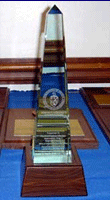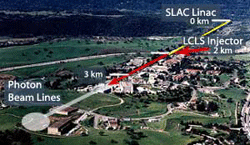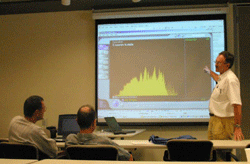

Contents of this Issue:
1. Science Highlight —
Resurrecting the Dead and the Deadly
(contact: Ian A. Wilson,
wilson@scripps.edu )
Researchers have literally unearthed clues as to why the 1918 influenza pandemic was so deadly. The 1918 influenza pandemic ranks as the largest and most destructive outbreak of an infectious disease, killing 20 to 40 million people worldwide. Using fragments of the flu genome from Alaskan victims preserved by permafrost and army autopsy tissues, James Stevens and Ian Wilson of the Scripps Research Institute in La Jolla, California and their collaborators have assembled genes from the 1918 flu virus.
The Scripps researchers then cloned, expressed and crystallized the viral protein, called hemagglutinin (HA) and utilized SSRL's macromolecular crystallography beam lines to reveal the coils, stalks and heads that make up HA's structure. The intricate structure helps explain why the 1918 flu virus was unusually virulent. HA is the most abundant protein on the virus's surface and as such is the main target for the immune system to try to defend against infection. For the virus, HA is also very important because it binds to human lung cells and enables the virus to get internalized into the cell inside sacs called vesicles. Once inside, HA changes shape to help the viral membrane fuse to the vesicle membrane allowing for infection to proceed. While 1918 HA appeared to be at the base of the evolutionary tree of human viruses, its structural analysis shows that it is actually more closely related to avian (bird) forms.
Two features of the structure particularly stand out in potentially
contributing to the extraordinarily high infectivity and mortality rates
observed in 1918. The receptor binding site (for the virus to attach to human
cells) is narrow and is only a single mutation away from a known swine-avian
virus. The mutation makes the binding site slightly larger, which could
increase affinity for human cells. The researchers also observed two previously
unseen basic patches (histidine rich) which may boost HA infectivity when it
fuses to the vesicle membrane in order to escape and replicate itself inside
human cells. One of the patches is found only in avian forms of HA, "providing
tantalizing evidence of a direct jump of this virus from birds to the human
na´ve population," said the researchers. To learn more about this recent
article in Science, see:
http://www-ssrl.slac.stanford.edu/research/highlights_archive/1918flu.
html
or
http://www-ssrl.slac.stanford.edu/research/highlights_archive/1918flu.pdf
2. Science Highlight —
Understanding the Role of Thiolate Ligation in Nature's
Hydroxylating Heme Enzymes
(contact: Michael T. Green,
mtg10@psu.edu)
Chloroperoxidase is one of a large class of heme proteins that play important
roles in a number of physiological processes, including xenobiotic metabolism,
neurological development, blood pressure control, and immune defense. These
heme protein systems all have the ability to oxygenate saturated hydrocarbons
under ambient conditions, a process which is chemically quite challenging, and
hence is also of industrial importance. Recently, extended x-ray absorption
fine structure (EXAFS) spectroscopy experiments conducted at SSRL by Michael
Green (Pennsylvania State University) and his coworkers have been used to
provide the first structural characterization of the oxygen intermediate of
chloroperoxidase. The results demonstrate that the intermediate is a protonated
ferryl species, which is in contrast to the widely accepted porphyrin-radical
cation model. These results have important implications for understanding the
mechanism of numerous heme enzymes, and EXAFS is one of the only methods that
could provide this type of structural information on the intermediate. To learn
more about this recent article in Science, see:
http://www-ssrl.slac.stanford.edu/research/highlights_archive/p450.
html
or
http://www-ssrl.slac.stanford.edu/research/highlights_archive/p450.pdf
3. SPEAR3 Receives DOE Excellence in Project
Acquisition Award
(contact: Keith Hodgson,
hodgson@ssrl.slac.stanford.edu)
 |
4. SSRLUOEC and SSRL Plan Annual Users' Meeting
and Workshops, October 20-26
On July 30, the SSRL Users' Organization Executive Committee (SSRLUOEC) met
with SSRL management to discuss a number of topics, including planning the 2004
Users' Meeting. The 31st Annual SSRL Users' Meeting on October 20-22 will
feature presentations to help users incorporate new technology and make the
most of SPEAR3 beam time as well as sessions on spectroscopy, scattering and
diffraction; reports from SSRL staff and young investigators; and a special
session on the history and future of photoemission in memory of W. E. Spicer.
Please register at: http://www-
conf.slac.stanford.edu/ssrl/2004/reg/reg.asp
Users are encouraged to submit abstracts for poster presentations by September
24. Graduate students, in particular, are encouraged to participate in the
meeting and in the graduate student poster competition. Registration fees are
significantly discounted for students, and the cost to attend the awards dinner
will be waived for students submitting posters.
http://www-
conf.slac.stanford.edu/ssrl/2004/reg/abs.asp
Three concurrent workshops will be held before the annual Users' Meeting on
Wednesday, October 20, 2004:
|
|
Nominations for the 2004 Farrel W. Lytle Award are due before September 10. The Lytle Award is presented annually at the Users' Meeting to recognize important technical or scientific accomplishments in synchrotron radiation-based science and to foster collaboration and efficient use of beam time among users and staff at the Stanford Synchrotron Radiation Laboratory (SSRL). http://www-conf.slac.stanford.edu/ssrl/2004/lytle.htm
Nominations for the SSRL Users' Organization Executive Committee Election are due before September 24. Users are encouraged to nominate candidates for the 7 vacancies in 2005; ballots will be prepared and circulated electronically in late September, and the election results will be announced at the Users' Meeting awards dinner on Thursday, October 21.
For more details regarding the upcoming Users' Meeting see:
http://www-conf.slac.stanford.edu/ssrl/2004/default.htm
5. LCLS Division Formed at SLAC
(contacts: John Galayda,
galayda@slac.stanford.edu)
 |
However, before the LCLS comes online there have been, and will continue to be,
reviews and approvals along the way to keep the project on track. A second DOE
construction management (Lehman) review was held August 10-12, with the purpose
of reviewing all aspects of the project's design and long-lead procurement
plans - technical, conventional construction, cost, schedule, management, and
ES&H to determine the project's readiness for Critical Decision 2b (CD-2b,
Approve Performance Baseline) and CD-3a (Approve Start of Long-Lead
Procurement). Comments made at the closeout session were very favorable; the
reviewers were impressed with the progress made thus far and had relatively
minimal concerns. Dr. Patricia Dehmer, DOE Associate Director for BES,
indicated that there is very strong support in Washington to ensure the on time
and successful completion of the LCLS. For more information on the LCLS see:
http://www-ssrl.slac.stanford.edu/lcls/
6. Report on the ICFA Future Light Sources Subpanel
on XFEL Short Bunch Measurement and Timing
(contact: Jerry Hastings,
jbh@slac.stanford.edu)
The ICFA Future Light Sources Subpanel has sponsored a number of workshops focusing on accelerator issues critical to the development of free electron lasers that will operate in the hard x-ray regime. The LCLS has jointly organized several of these with the European XFEL project centered at DESY in Hamburg Germany. The most recent present workshop held July 26-30 focused on issues that will be critical to the optimal utilization of the short pulses (~ 100 fs) that these machines will deliver: measurement of the electron and photon bunch lengths and the timing systems for the accelerator and the synchronization of experimental lasers to the FEL photon beam. Approximately 50 participants from all over the world gathered at SLAC for the 5-day event.
 |
Further details of the workshop can be found at:
http://www-ssrl.slac.stanford.edu/lcls/xfel2004/
7. Educating Scientists in the Use of SR Techniques
- the SMB 2004 Summer School
(contact: Serena DeBeer George,
serena@slac.stanford.edu)
The fourth in a series of structural molecular biology (SMB) summer schools was held at SSRL August 16-20. The school focused on the following synchrotron-based techniques: x-ray absorption spectroscopy, small angle x-ray scattering, and macromolecular crystallography, and the application of these techniques to biological problems. The summer school opened with introductory talks on synchrotron radiation and beam line optics. Three days of lectures followed, providing an introduction to each of the three techniques, as well as covering basic theory, experimental considerations, and applications. The lecture portion was followed by a day and a half of rotating practical sessions, giving the students hands-on experience in data collection and analysis. This year's summer school was attended by 23 students and was led by a team of 18 tutors (all of whom are recognized experts in their field). The lectures and practical sessions were enthusiastically received by the participants, and we hope to build on the success of this year's summer school to make next year's an even bigger success.
8. SSRL Proposal Review Panel and NIH SMB Advisory
Committee Meetings
(contacts: Keith Hodgson,
hodgson@ssrl.slac.stanford.edu; Britt Hedman, hedman@ssrl.slac.stanford.edu)
The Proposal Review Panel (PRP) met for the 56th time July 30-31, 2004. The PRP plays a critical role in the peer-reviewed proposal process as well as providing strategic advice and guidance on SSRL's programs and long-range planning. Several presentations were made during this meeting including: SSRL Director's Report (Keith Hodgson), Beam Line/Operations Update (Britt Hedman, Piero Pianetta), SSRLUO Executive Committee Report (Benjamin Bostick), User Administration (Cathy Knotts), and LCLS (John Galayda). The PRP reviewed 22 new proposals and considered a number of proposal extension requests. At the closing session on Saturday, PRP Chair Russ Chianelli (UTEP) recognized the outstanding results related to the SPEAR3 upgrade, beam line development, and user support. The SSRL NIH Structural Molecular Biology Advisory Committee also met on Saturday, July 31, to review activities and discuss strategies for the future.
9. User Research Administration Announcements
(contacts: Cathy Knotts,
knotts@slac.stanford.edu; Lisa Dunn, lisa@slac.stanford.edu)
New Proposals Due November 1 (X-ray/VUV) and December (MC): If your current
proposal is getting close to its expiration date or if you are planning to
conduct new experiments, consider submitting a new X-ray and VUV proposal by
the November 1, 2004 deadline or a new Macromolecular Crystallography proposal
by the December 1, 2004 deadline. Proposals submitted by these dates will be
peer reviewed, rated, and eligible for beam time in spring 2005. For more
information of the proposal submittal, review and scheduling process, visit:
http://www-ssrl.slac.stanford.edu/users/user_admin/guide.html
__________________________________________________________________________
SSRL Headlines is published electronically monthly to inform SSRL users, sponsors and other interested people about happenings at SSRL. SSRL is a national synchrotron user facility operated by Stanford University for the U.S. Department of Energy Office of Basic Energy Sciences. Additional support for the structural biology program is provided by the DOE Office of Biological and Environmental Research, the NIH National Center for Research Resources and the NIH Institute for General Medical Sciences. Additional information about SSRL and its operation and schedules is available from the SSRL WWW site.
__________________________________________________________________________
To leave the SSRL-HEADLINES distribution, send email as shown below:
To: LISTSERV@SSRL.SLAC.STANFORD.EDU Subject: (blank, or anything you like)
The message body should read
SIGNOFF SSRL-HEADLINES
That's all it takes. (If we have an old email address for you that is forwarded to your current address, the system may not recognize who should be unsubscribed. In that case please write to ssrl-headlines-request@ssrl.slac.stanford.edu and we'll try to figure out who you are so that you can be unsubscribed.)
If a colleague would like to subscribe to the list, he or she should send To: LISTSERV@SSRL.SLAC.STANFORD.EDU and use the message body
SUBSCRIBE SSRL-HEADLINES
|
SSRL Welcome
Page | Research
Highlights | Beam Lines | Accel
Physics
User Admin | News & Events | Safety Office |